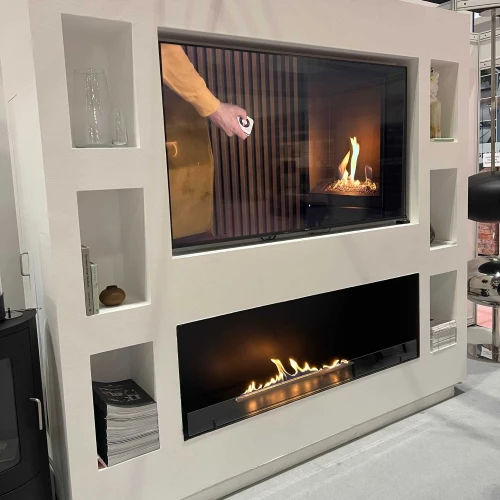What is a Bioethanol Fireplace?
Bioethanol fireplaces are innovative heating solutions that use bioethanol fuel derived from plant-based sources to produce real flames without the need for a chimney or flue. These fireplaces offer significant advantages, including ease of installation, eco-friendliness, and a sleek design, making them a popular choice for homeowners seeking a sustainable heating option. While they provide a cosy atmosphere and supplementary heat, their heat output may be lower than traditional wood-burning or gas fireplaces, and they require careful consideration of fuel costs and proper ventilation.
Bioethanol fireplaces come in a range of designs, including freestanding units, wall-mounted styles, and tabletop models. Their sleek and contemporary appearance makes them a popular choice for many households. Moreover, some models feature innovative elements such as glass panels, offering an unobstructed view of the dancing flames and enhancing the overall aesthetic appeal.
Bioethanol Fireplaces as a Sustainable Option
A bioethanol fireplace, also known as an ethanol fire or ethanol fireplace, is a modern and eco-friendly alternative to traditional wood-burning or gas fireplaces. It utilises bioethanol, a renewable and clean-burning fuel, to generate a real flame and heat without the necessity for a chimney or flue. This innovative heating solution has gained popularity due to its convenience, versatility, and environmentally friendly nature.
The bioethanol fireplace operates on the principle of burning bioethanol fuel, also referred to as biofuel, which is derived from organic matter such as corn, sugarcane, or other plant-based sources. It is considered a sustainable and carbon-neutral fuel as it releases only minimal amounts of carbon dioxide and water vapour during combustion, making it a cleaner option compared to fossil fuels.
Is it Safe to Use a Bio Ethanol Fireplace?
Using a bioethanol fireplace is perfectly safe, provided you exercise common sense. Essentially, there are no additional safety precautions you need to consider when operating a biofuel fireplace. Nevertheless, all our bioethanol fires comply with the TÜV safety standards for fireplaces that burn flammable liquids.
We advise treating a bioethanol fire in the same manner as you would any other fireplace or fire pit that involves open flames. It's crucial to remember that the fuel box can remain hot even after the fire has been extinguished, so refrain from refuelling the fireplace while it is still hot to avoid accidents.
Ensure that your burner and the surrounding frame are constructed from non-combustible materials. Many people mistakenly opt for MDF when installing their bio fireplace into a wall. However, this material is not recommended for built-in fireplaces, and you should use fireproof materials instead.
Read more about the safety of bioethanol fires here.
How Long Can a Bioethanol Fire Burn?
The burn time of a bioethanol fireplace depends on several factors. It depends on the size of the burner, which determines how long a bio fireplace can burn. In addition, the strength of the flame, i.e. the size of the flame, has an impact on the burning time. The smaller the flame, the less bio ethanol fuel the fire consumes, and thus the longer the burn time.
How long does one litre of bioethanol fuel burn? As a rule of thumb, we say that 1 litre of bioethanol fuel can burn for 2 to 4 hours - subject to the above mentioned, of course. Depending on how much bioethanol is used, as well as which type of burner it is, the flames can vary in size and burn time.
The quality of the bioethanol used is also an important factor in the time the burner runs for. At Bioethanol-fireplace.co.uk, we always purchase high quality bio ethanol fuel, which ensures that the burn time is as optimal as possible. You can find our high-quality bioethanol here.
What is bioethanol fuel exactly? The quick and simple answer is this: bioethanol fuel is a sustainable fuel designed to be completely safe to use. It is comprised of natural materials and prevents the emission of CO2 when burning it. This means that no chimney is needed for bioethanol fires either.
We offer burners in many different sizes, in fact everything from 0.3 litres of capacity all the way up to 22.5 litres. So the time our bioethanol stoves can burn on one filling of bio ethanol fuel varies a lot.
We have, therefore, made sure that under the specifications of each bioethanol fire, you can find information on how long each bio fireplace can burn on one filling.
.jpeg)
How Does a Bioethanol Fireplace Work?
A bioethanol fireplace operates by burning bioethanol fuel, a renewable energy source derived from plant-based materials such as sugarcane and corn. This clean-burning fuel is poured into a designated fuel container or burner tray within the fireplace. Once filled, the fuel is ignited using a long lighter or match, producing real flames that provide both warmth and a cosy atmosphere.
As the bioethanol fuel burns, it emits minimal amounts of carbon dioxide and water vapour, making it an environmentally friendly option compared to traditional wood-burning or gas fireplaces. These fireplaces do not produce soot, ash, or smoke, eliminating the need for a chimney or flue and simplifying installation.
The operation of a bioethanol fireplace is incredibly easy and flexible. Some models come equipped with features such as adjustable flames, allowing users to control the intensity and height of the fire. Additionally, the lack of a need for electricity or a gas connection means they can be placed in various locations within the home, offering versatility in design and placement.
Overall, bioethanol fireplaces provide a simple and efficient way to enjoy the beauty of a real flame, while also being a sustainable and eco-friendly heating solution.







